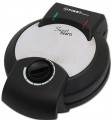Power
Electrical power consumed by the device during operation. A more
powerful appliance spends less time cooking to readiness; at the same time, the high consumption of electricity is often offset by the speed of cooking (in other words, the device simply does not have time to "eat" a lot of energy). However, such a device will also cost more. Therefore, it makes sense to specifically look for such a technique mainly in cases where “every extra second matters” — for example, if a toaster is bought for a cafe or diner where you need to cook quickly and in large quantities.
Also note that a device with a large capacity will inevitably require a higher power.
Number of products
The maximum number of individual products that can be cooked in the appliance at the same time.
For toasters, this parameter corresponds to the number of standard rectangular pieces of bread that fit into the device. Accordingly, if the size of the blanks used differs from the standard, then the capacity may be more or less than the claimed one.
If we are talking about a waffle iron, cake-pans or other device of a similar design (see "Type"), then the number of products is usually indicated by the number of notches on the working surface. In this case, note that the larger the capacity, the smaller the size of each product (especially since the working surface area for different models does not differ so much).
Control
The type of control provided in the device.
-
Mechanical. Mechanical systems are systems in which the control elements are connected to the working elements of the device directly, without the “mediation” of electronic circuits. For example, the power button in such models directly closes and opens the power circuit, the rotary knob of the thermostat rotates the rheostat, which changes the current strength in the heater, etc. Such control, which is mainly implemented by a rotary switch, is simple, reliable and at the same time low cost. True, it does not allow the implementation of some functions and is not particularly accurate in adjusting individual parameters (timer settings, heater temperature); however, in the case of these shortcomings often turn out to be insignificant. Therefore, most of these devices nowadays use this type of control.
-
Push-button. Push-button control is based on electronic circuits. Such systems are more accurate than mechanical ones; more capabilities and modes are provided. On the other hand, such control is more complex and more expensive than mechanical control.
-
Touch. A type of
electronic control with touch switches. Compared to push-button models, it provides a high level of comfort in operation, and looks more modern and aesthetically pleasing.
Fixation clamp
A special device that holds together the halves of a sandwich maker or other similar device (see "Type") and prevents them from opening during operation.
Material
The main material used in the body of the device.
—
Plastic. Plastic is an affordable and practical material that offers functionality in various applications. Its lightweight nature makes it suitable for complex shapes, and it can be easily colored to match any desired aesthetic. Additionally, plastic's low thermal conductivity helps conserve energy and reduces the risk of burns from touching the device's exterior. While plastic may not match the strength and scratch resistance of metal, these aspects primarily impact the device's appearance rather than its critical functionality. One significant drawback is plastic's limited heat resistance, which necessitates additional thermal insulation and makes it less reliable in case of malfunctions. Plastic is found across different price ranges, but it is particularly popular in relatively inexpensive devices.
—
Steel. Steel cases are known for their exceptional strength and reliability, surpassing plastic cases in scratch resistance and ability to withstand high temperatures. The solid appearance of steel adds to its appeal. However, steel is considerably more expensive, making all-metal cases more commonly found in mid-range and high-end devices. In budget-friendly devices, steel is often used as an additional decorative coating on top of plastic or only in specific areas of the case, typically near the heating element where enhanced durabil
...ity is required.
— Glass. When it comes to kitchen appliances, it is impractical to construct the entire case out of glass. Instead, glass is typically used for separate parts, often the front and back panels, while the rest of the body is made of metal and/or plastic. Glass inserts provide a unique aesthetic appeal, allowing a glimpse of the device's internal components without the need to open the case. However, this design is expensive and lacks practical advantages compared to more traditional materials. Even tempered and heat-resistant glass remains fragile. As a result, such cases are extremely rare and usually found in designer models.
